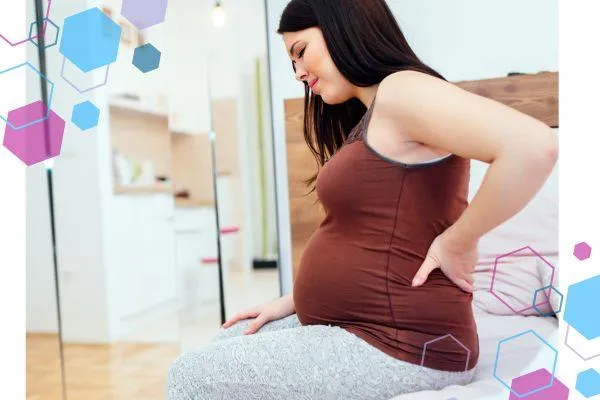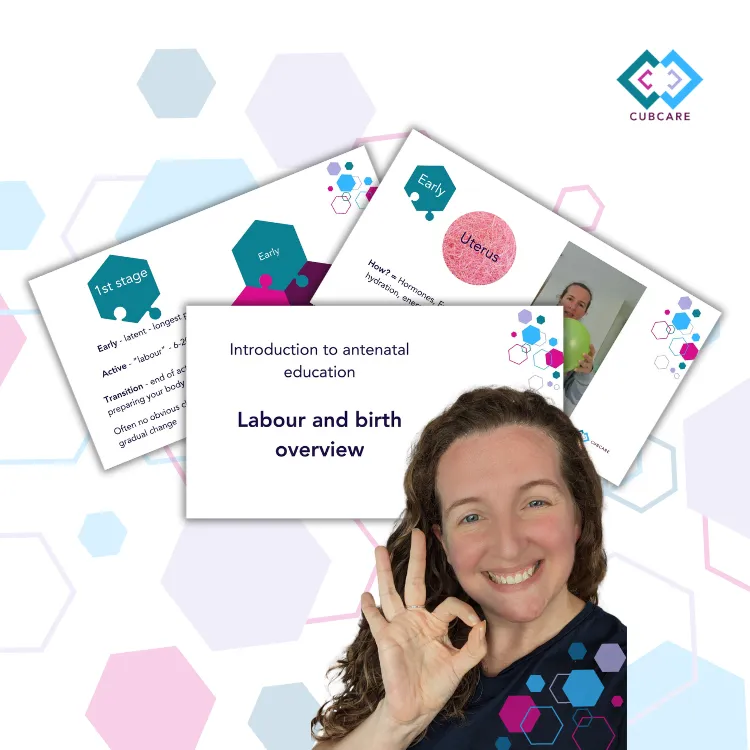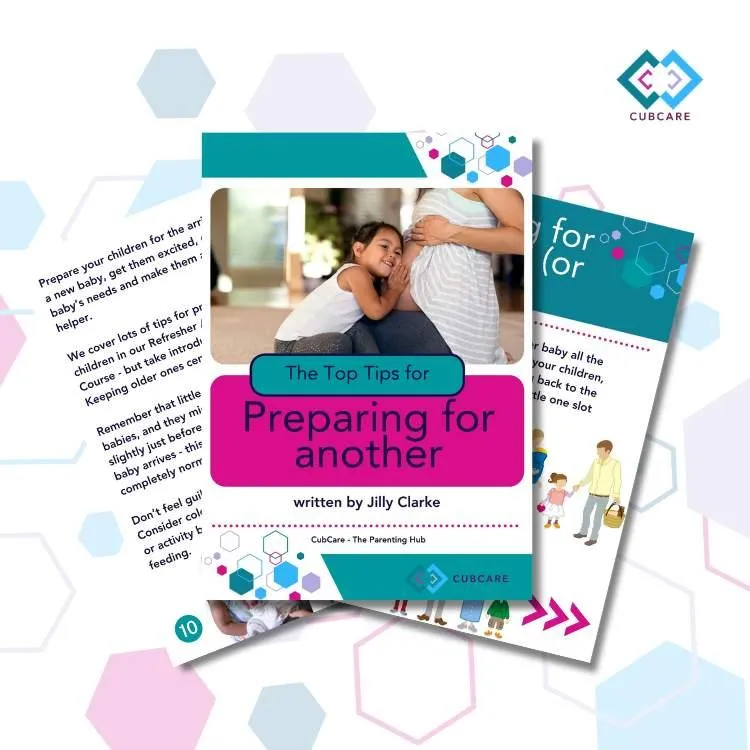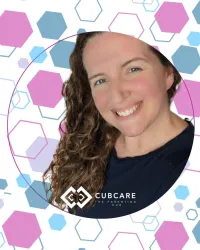We're an award winning Antenatal and Postnatal Education Platform 2025!
(read more here)
CubCare blogs.
From early pregnancy to newborn development.
Advice to help through pregnancy, birth and childhood.
BLOG

Pregnancy with Hypermobility: What to Expect & Prepare
"Hypermobility Spectrum Disorder/hEDS isn’t a weakness. It’s just a different way of being in your body. And when you understand how to work with it, pregnancy and birth can be positive and powerful." - Jilly Clarke
If you're pregnant and living with Hypermobility Spectrum Disorder (HSD) or hypermobile Ehlers-Danlos Syndrome (hEDS), you may already feel like your body doesn’t quite fit the standard mould.
You might be dealing with symptoms that medical professionals brush off. Struggling to deal with every day events that other people seem to cope with easily.
You might be doing your own research because the advice you’re getting doesn’t feel right.
You might be navigating appointments where your real needs are minimised or misunderstood.
This blog is a starting point. A way to bring together what should be widely known, but often isn’t. If you want to go deeper into symptom management, movement strategies, birth planning and postnatal recovery, my Pregnancy and Birth with Hypermobility course is designed specifically for that.
How does Hypermobility (HSD/hEDS) affect pregnancy?
Hypermobility isn’t just about flexibility. In HSD and hEDS, the connective tissue that supports your joints, organs and blood vessels is more elastic and less stable. This can impact nearly every system in the body, especially under the physiological demands of pregnancy.
Hormonal changes like increased relaxin and progesterone can further destabilise joints and amplify systemic symptoms.
According to the Ehlers-Danlos Society and Castori et al. (2012), pregnancy in people with HSD/hEDS commonly involves:
Pelvic girdle pain (PGP) or joint instability
Fatigue that doesn’t improve with rest
Dizziness, faintness or postural tachycardia
Digestive discomfort, reflux or bloating
Musculoskeletal pain and heightened sensitivity
Delayed recovery after exertion
Despite this, many people are told their symptoms are “normal for pregnancy.” That dismissal not only undermines confidence—it creates risk.

Labour and birth: why it’s different when you're hypermobile - and sometimes more efficient
People with HSD/hEDS are sometimes labelled “high risk” without nuance or clarity, and sometimes overlooked by medical professionals as just "a bit bendy". But the actual evidence points to a more balanced picture.
A review by Hakim & Sahota (2006) and a population-based study by Kulas Søborg et al. (2023) found that while hypermobile people may be more likely to experience obstetric intervention, many go on to have spontaneous, uncomplicated births - particularly when care is adapted to their needs.
There are even potential physiological advantages:
Greater pelvic mobility may offer more space during descent
Softer tissue may allow for more efficient dilation and rotation
Upright or active labour positions can work especially well
Some people experience shorter labours than average
However, risks do exist:
Increased sensitivity to pain or overstimulation
Tearing due to tissue fragility (De Paepe & Malfait, 2006)
Reduced response to regional anaesthesia in some cases
Joint instability during unsupported movements or pushing
The takeaway? Your birth experience is not predetermined by your diagnosis—but your preparation needs to reflect your physiology.

How to plan for birth with hypermobility in mind
A well-informed, flexible birth plan can make a huge difference to the pregnancy and birth experience of those with Hypermobile Spectrum Disorders or Hypermobile Ehlers-Danlos Syndrome.
Consider including:
A note on joint instability and your preferred labour positions (e.g. supported kneeling, upright, or water immersion)
Your previous experience with pain relief, anaesthetics, or mobility challenges
A request for continuity of care where possible (to avoid re-explaining symptoms)
A need for extra time and communication between procedures or decisions
Partner support roles: spotting fatigue, helping with comfort, advocating when needed
Personalising your birth plan means creating the safest, most supportive path for your unique body.
Physical and emotional preparation during pregnancy
People with HSD/hEDS are often told to “stay active” in every day life, and particularly during pregnancy. Staying mobile can be incredibly helpful, to stop muscles and joints getting stiff, to hold themselves against the instability that pregnancy brings.
But vague advice can be unhelpful or even harmful if people don't understand their own body. What you need is movement that protects joints, builds functional strength, and supports nervous system regulation.
In my work with hypermobile clients, I often recommend:
Joint-stabilising movement such as adapted pregnancy yoga or guided physio
Pacing strategies that prevent burnout and symptom flares
Breathwork and body awareness for pain management and calm
Partner preparation to ensure shared knowledge and support in birth
Preparation shouldn’t mean pushing harder. It should mean working smarter - with your body, not against it.

Recovery after birth with HSD/hEDS
This is often the most overlooked phase of care for hypermobile people.
Malfait et al. (2017) and the Ehlers-Danlos Society recommend a slower, joint-safe approach to postnatal recovery—especially in the first 6–12 weeks. Many people find that sleep deprivation, feeding positions, and repetitive lifting can quickly trigger fatigue, pain, or autonomic symptoms.
You might need:
More time lying down or reclined
Extra support for feeding and resting positions
Gentle, progressive reintroduction of movement
Clarity about pacing, rest, and recognising signs of dysregulation
Postnatal recovery isn’t about getting “back to normal.” It’s about supporting your body in a way that respects what it’s just done—and what it needs to heal.
Why holistic preparation works best with HSD/hEDS
There’s no universal prescription for hypermobile pregnancy—but a joined-up, holistic approach is often the most effective.
That means:
Movement strategies that stabilise and strengthen
Nervous system support that builds confidence
Practical tools for appointments, advocacy and pacing
Flexible but informed recovery plans
Professionals who listen, adapt, and trust your insight
You may also benefit from personalised nutritional advice, especially if digestion is affected—but this should be explored with a qualified nutritionist or dietitian.
Holistic isn’t about going “alternative.” It’s about taking your whole body, whole experience, and whole nervous system into account.
Your body is not a problem
If you’ve ever felt like your needs were too complicated, too hard to explain, or simply brushed off then you’re not alone. It can be self-preservation to keep quiet in the fact of new, or worsening symptoms, for fear of the same thing happening again.
“People with hypermobile Ehlers-Danlos often face years of misdiagnosis or dismissal, with significant impact on their quality of life.” — Rombaut et al. (2011)
But your experience matters. Your instincts are valid. And with the right preparation and support, your pregnancy and birth can feel informed, supported, and even empowering.
My Pregnancy and Birth with Hypermobility course is the first of its kind—built specifically for people with HSD or hEDS who want clear, evidence-based guidance through pregnancy, labour, and postnatal recovery.
Inside, we’ll cover:
How to move, breathe and rest in ways that support your joints
How to advocate for your care without burnout
How to prepare for a birth that works with your physiology - not against it
How to recover at your own pace, with compassion and clarity
🔗 Explore the course and enrol here
Because “you’re fine” is not the same as being supported.
And you deserve more than reassurance—you deserve a plan that works.
You don’t need to do this alone.
And you never were meant to.
Refresher Antenatal Course in person
Refresher Antenatal Course online
Birth Partner course (included in our Antenatal course)
Antenatal Course in person
Antenatal Course online
Easily navigate to our most popular Blog categories
Download our Freebies

Labour and Birth
Watch our introduction to antenatal education webinar, our labour and birth overview - to start your antenatal education journey. Understanding the process, and what you can do to influence it.

Pregnancy Planner
Free Pregnancy Planner to help you prepare for a little one. Prepare your body, your mind, your finances and your home. Get organised, feel good and prepare for an active, positive birth.

Birth Partner Guide
Your ultimate guide to being the best birth partner during pregnancy, birth and recovery. Learn what you need to do, and what you need to learn to be the best birth partner possible.

Expecting Again Guide
Your ultimate guide to preparing for another birth and an extra baby. Our top tips for navigating pregnancy and birth, and helping your older ones to transition into their new role as a big sibling.
Based in Welwyn Hatfield, offering local pregnancy support and doula services across Hertfordshire: St Albans, Hatfield, Welwyn Garden City, Potters Bar, Stevenage, Harpenden, Hitchin, Barnet, Mill Hill and surrounding areas.
Online antenatal and postnatal education available UK-wide.
© Copyright 2025 CubCare The Parenting Hub. CubCare is operated by The Birth and Baby Company Ltd. Company No. 15655287
Privacy Policy | Terms & Conditions | Medical Disclaimer | Inclusivity and Accessibility

